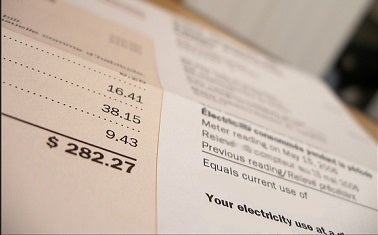Good News: EPA Standards Could Lower Electricity Bills
 Millions of Americans are watching their bills more closely as middle-class incomes continue to stagnate in the nation’s uneven economic recovery.
Millions of Americans are watching their bills more closely as middle-class incomes continue to stagnate in the nation’s uneven economic recovery.
So it’s frustrating to hear opponents of climate action once again use the threat of higher electricity rates as a scare tactic to try to stop the U.S. Environmental Protection Agency’s Clean Power Plan. We know it has many people concerned.
The good news is we have more evidence than ever before to prove our opponents wrong.
We pay the same rates for power now as in 1994
Electric rates in the United States have remained steady over the last 20 years, even as consumption of renewable energy increased 40 percent, statistics from the U.S. Energy Information Administration show. Over the same time, we reduced coal plant emissions of sulfur dioxide and nitrogen oxides by more than 75 percent.
The power sector has a long history of implementing clean air standards while delivering reliable power and doing so at lower-than-anticipated costs. Not surprisingly, EPA’s modeling shows that the average monthly electric bill will be $8 lower in 2030 with the Clean Power Plan than without it.
So why, then, would fossil fuel interest groups claim that electric bills are going to drastically increase whenever we talk about clean energy and reducing pollution from power plants?
It comes down to this: The proposed Clean Power Plan will place the first-ever national limits on carbon pollution emitted by power plants in the United States – a proposed rule that will shift the market toward clean energy and away from the dirtiest power producers and their shareholders.
Opponents of EPA’s plan point to utility bills – when it’s really about defeating clean air policies.
States would need to ramp up carbon-reducing measures such as energy efficiency and installation of renewable energy sources so the power sector as a whole can cut emissions by 30 percent in 2030, from 2005 levels.
Of course, nobody really opposes clean air. This is why opponents of EPA’s plan point to utility bills – when it’s really about defeating clean air policies.
Energy efficiency can save us billions
In California, the state’s efficiency standards have saved Californians $74 billion and avoided the construction of more than 30 power plants.
Now, remember that as our coal fleet continues to age it must be replaced, anyway. The industry is already facing competitive pressure from low- and zero-carbon resources – with or without new policies.
New coal-fired power plants are one of the costliest generation options even without considering the significant pollution they generate. If built in the next five years, they would cost about 19 percent more than onshore wind, 44 percent more than combined cycle natural gas, and significantly more than energy efficiency measures.
The energy sector is entering a new era, even if some players have yet to get onboard.
Clean power is already lowering bills
The cost of renewable energy has been dropping dramatically and wind is now competitive with coal in some places. The top 10 wind-producing states have average residential electricity prices that are lower than the national average.
The Clean Power Plan may just spell out what many in the industry already knew: Fossil fuels are not as cheap as they may seem. So why do opponents think they can fool consumers into thinking they’re better off with pollution?
Beats me. Today, more than ever before, we can show that clean energy is a good deal for you and me.
Photo source: Brendan Wood
This post originally appeared on the EDF Voices Blog.











One Comment
Only about a third of the charges on your electricity bill come from the wholesale purchase of power. The other 2/3 come from electricity distribution and billing. So even though the wholesale cost of electricity may stabilize, the other costs of line maintenance, power delivery and overhead will undoubtedly continue to rise. AS long as we are embedded in a “must have growth” economy, the idea of flat electric rates is a vain chimera.